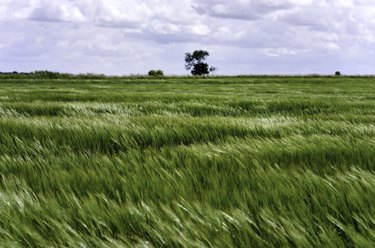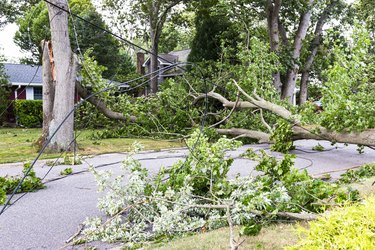
Different types of fronts in weather can be caused by a number of physical phenomena on the planet. So many things can affect the flow of air (from humidity to wind strength to temperature to landforms, like oceans and mountains) that it's sometimes hard to believe scientists can predict anything about it. It may be easier to wrap your head around how weather moves and what happens when warm air rises if you think back to a few physics examples you may have heard once upon a time.
The Physics of Air
Video of the Day
In order to understand the weather, you'll need to understand a little bit about physics. Most materials on our planet expand when heated and contract when cooled, air included. Consider a hot air balloon. As the air inside the balloon is heated, the balloon rises into the sky. This is because the warmer, less dense air captured in the balloon rises above the atmospheric air. Once the pilot stops applying heat to the balloon and starts slowly letting the warm air out, the balloon will sink back to earth.
Video of the Day
This principle involves not just heat but also density – the mass of a substance present in a specific unit of volume. For this, consider oil and vinegar in a salad dressing bottle. The vinegar separates out to the bottom, leaving the oil to sit on the top. This is because vinegar has a higher density than oil. In the case of the balloon, both materials in question are air, but the warm air has a lower density and thus rises to the top. As the air cools, raising its density, the balloon sinks through the atmosphere and lets gravity pull it to earth.

In fact, matter and volume (like density), temperature and pressure are all related to each other by the Ideal Gas Law, an equation familiar to many scientists. The Ideal Gas Law says that changing one of those factors will cause changes in the rest of the factors in ways that scientists can predict to varying degrees of accuracy.
Different Types of Fronts
You may hear your radio talking about air masses moving in and producing fronts, which can provide wind, rain and occasionally great storms. A warm front occurs when warm air is being pushed by planetary wind into a mass of colder air. The warm air will rise over the cold air until it then cools, which will form clouds. This is what happens when warm air rises, assuming the air over which it rises is colder than it is.
The warm air that has risen will also pave the way for additional weather patterns. This is because the boundary where these two air masses meet, called the front, often yields rain or snow as a result. As you might expect, a cold front occurs when cold air is moving into a mass of warm air. The cold air pushes the warm air higher until it cools off, which can produce enormous clouds and rain.
More on Rain and Storm Fronts

Rain and storm fronts happen because of additional interactions between temperature and density. Warmer air will have a lower density and can also hold more water vapor than cold air, but as this warm air rises into our atmosphere, it cools, mainly because the outer edges of our atmosphere are colder than the surface of the earth.
As the air cools, it won't be able to hold as much water vapor. The water vapor condenses, first into clouds and then sometimes into rain.